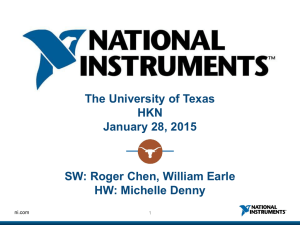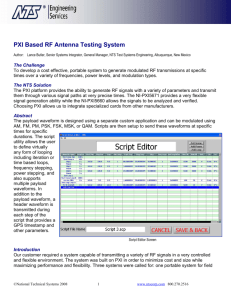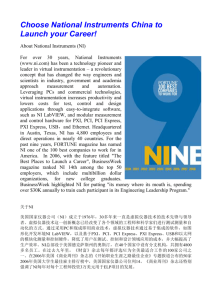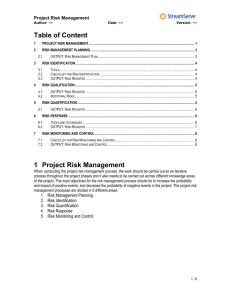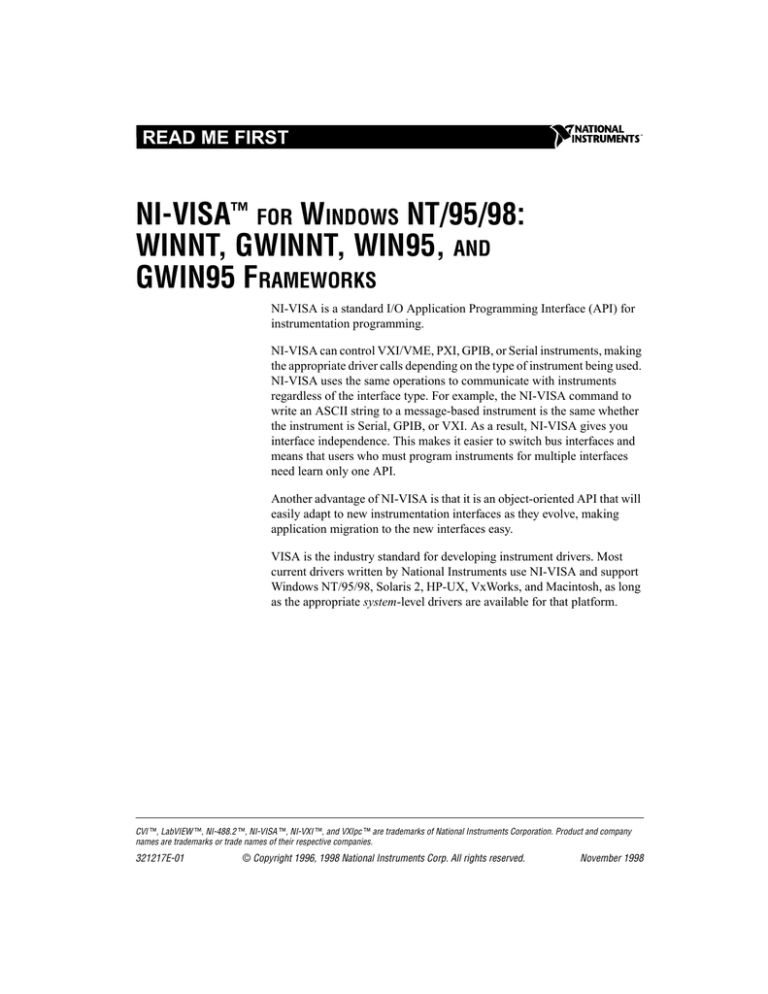
READ ME FIRST
NI-VISA™ FOR WINDOWS NT/95/98:
WINNT, GWINNT, WIN95, AND
GWIN95 FRAMEWORKS
NI-VISA is a standard I/O Application Programming Interface (API) for
instrumentation programming.
NI-VISA can control VXI/VME, PXI, GPIB, or Serial instruments, making
the appropriate driver calls depending on the type of instrument being used.
NI-VISA uses the same operations to communicate with instruments
regardless of the interface type. For example, the NI-VISA command to
write an ASCII string to a message-based instrument is the same whether
the instrument is Serial, GPIB, or VXI. As a result, NI-VISA gives you
interface independence. This makes it easier to switch bus interfaces and
means that users who must program instruments for multiple interfaces
need learn only one API.
Another advantage of NI-VISA is that it is an object-oriented API that will
easily adapt to new instrumentation interfaces as they evolve, making
application migration to the new interfaces easy.
VISA is the industry standard for developing instrument drivers. Most
current drivers written by National Instruments use NI-VISA and support
Windows NT/95/98, Solaris 2, HP-UX, VxWorks, and Macintosh, as long
as the appropriate system-level drivers are available for that platform.
CVI ™, LabVIEW ™, NI-488.2 ™, NI-VISA ™, NI-VXI ™, and VXIpc ™ are trademarks of National Instruments Corporation. Product and company
names are trademarks or trade names of their respective companies.
321217E-01
© Copyright 1996, 1998 National Instruments Corp. All rights reserved.
November 1998
Contents
What Do You Have?................................................................................2
Software............................................................................................2
Acrobat (Online) Documentation .....................................................3
Utilities ....................................................................................................3
Supported Application Development Environments ...............................4
Where Do You Start? ..............................................................................4
Step 1. Install LabVIEW and/or LabWindows/CVI.........................4
Step 2. Install Your NI-VXI/NI-488.2 Driver Software...................4
Step 3. Install Your NI-VISA Software ...........................................5
Start the Setup Program.............................................................5
Updating the NI-VISA Setup ....................................................6
Step 4. Check the Read-Me File.......................................................6
Using NI-VISA with PXI ........................................................................7
Start the PXI Setup Wizard ..............................................................7
Configure NI-VISA for PXI Interrupts ............................................8
Step 1: Detecting an Interrupt ...................................................8
Step 2: Acknowledging an Interrupt
from Your PXI Device ...........................................................9
Example.....................................................................................10
Device Manager Settings..................................................................11
Complete the PXI Device Registration ............................................13
Using PXI Resources in your VISA Application .............................13
Resource Manager Operations ..................................................13
What Do You Have?
Your kit contains the following software and documentation.
Software
The VXIplug&play disks are labeled NI-VISA for Windows NT/95/98
Version 2.0 and contain the following software components.
•
VISA Dynamic Link Library
•
VISA Microsoft C and Borland C Import Libraries
•
VISA Microsoft Visual Basic Support Files
•
VISA GPIB-VXI Component
•
VPP-6 Compliant Windows NT/95/98 Installer
The NI-VISA software in this kit is compatible with the WIN95/GWIN95
and WINNT/GWINNT frameworks (the WIN95/GWIN95 frameworks
include support for Windows 98). With NI-VISA installed on your
computer, you can run any VXIplug&play software compatible with these
NI-VISA for WIndows NT/95/98
2
© National Instruments Corporation
frameworks. This includes instrument drivers and executable soft front
panel software included with VXIplug&play-compatible instruments from
a variety of vendors.
Acrobat (Online) Documentation
Your kit includes online manuals in the form of Adobe Acrobat version 3.0
portable document format (PDF) files. The Acrobat manuals and their
installed locations are as follows.
•
The NI-VISA User Manual describes how to program using NI-VISA:
Start»Programs»VXIpnp»NI-VISA User Manual
•
The NI-VISA Programmer Reference Manual describes in detail the
attributes, events, and operations you use in NI-VISA:
Start»Programs»VXIpnp»NI-VISA Programmer
Reference Manual
If you do not have Adobe Acrobat Reader 3.0, you can download a copy
from the Adobe Web site at http://www.adobe.com/.
Utilities
This release of NI-VISA for Windows NT/95/98 includes utilities to help
you configure, develop, and debug your system quickly: T&M Explorer
and NI Spy.
You can use T&M Explorer to view your entire T&M system and configure
various components. When you launch T&M Explorer, a list of your VXI,
PXI, GPIB, and Serial devices appears on your screen. To view the
properties of each device (such as logical address, address space used, and
primary address), right-click on the device in the list. When you view the
properties of a National Instruments device, you can configure the
hardware settings directly from the properties list.
T&M Explorer replaces many earlier utilities, such as VXIedit and
VISAconf, and integrates with the NI-DAQ Configuration Utility
(for VXI-DAQ instruments). T&M Explorer also has new features, such
as an option to run Resource Manager at startup, and troubleshooting to
guide you through configuration conflicts and errors.
NI Spy tracks the calls your application makes to National Instruments
T&M drivers, including NI-VXI, NI-VISA, and NI-488.2. It highlights
functions that return errors, so you can quickly determine which functions
failed during your development. NI Spy can also log your program’s calls
to these drivers, so you can check them for errors at your convenience.
© National Instruments Corporation
3
NI-VISA for WIndows NT/95/98
For PXI instruments, you must register device information with NI-VISA.
See the section Using NI-VISA with PXI for information on how to do this,
along with a description of the PXI functionality NI-VISA supports.
Supported Application Development Environments
This release of NI-VISA for Windows NT/95/98 supports the following
Application Development Environments (ADEs):
Note
•
LabVIEW version 4.x, 5.x
•
LabWindows™/CVI version 4.x, 5.x
•
Borland C/C++ version 4.5.x
•
Microsoft Visual C/C++ version 4.x, 5.x, 6.x
•
Microsoft Visual Basic version 4.x, 5.x
Although NI-VISA has been tested and found to work with these ADEs, other
ADEs or higher versions of the ADEs listed above may also work.
Where Do You Start?
Step 1. Install LabVIEW and/or LabWindows/CVI
If you want to use LabVIEW and/or LabWindows/CVI as VISA
application development environments, install them first. The NI-VISA
installer will detect them and install the appropriate support files
automatically.
If you install LabVIEW and/or LabWindows CVI after you install VISA,
rerun the NI-VISA installer to get the latest VISA support files installed
correctly.
Step 2. Install Your NI-VXI/NI-488.2 Driver Software
The installation method varies depending on the type of controller you
purchased, as shown in the following table. Refer to the documentation
that came with your controller for detailed installation instructions.
Controller
Installation
VXI-PCI8000 MXI Controller
VXIpc 800/700/600 Series
VXI-1394 Controller
The NI-VXI/VISA kit installs both the NI-VXI and NI-VISA
driver software. You do not need to install this package
separately, unless this is an upgrade. Refer to the NI-VXI/VISA
Read Me First document for more information.
VXIpc-486 embedded controller
NI-VXI and NI-488.2 are already installed on your hard drive.
NI-VISA for WIndows NT/95/98
4
© National Instruments Corporation
Controller
Installation
VXI-AT2010 MXI Controller
Install the NI-VXI for Windows 3.x/NT software. See Note.
VXI-AT4000 MXI Controller
Install the NI-VXI for Windows 3.x software. See Note.
GPIB-VXI/C controller or any
National Instruments GPIB
board that has a Windows
NT/95/98 driver
Install the NI-488.2 for Windows NT/95/98 software.
You can also use a National Instruments serial board that works along with
the serial ports on your computer. If you are using only serial I/O, you do
not need to install NI-VXI or NI-488.2.
Because this implementation of VISA is a 32-bit driver, it looks for 32-bit versions
of NI-VXI and/or NI-488.2. If you are installing NI-VISA on Windows 95 and
have only 16-bit drivers, please contact National Instruments to request the
NI-VXI Upgrade for Windows 95 or the Compatibility Release for NI-488.2.
Note
Step 3. Install Your NI-VISA Software
Controller
Installation
VXIpc embedded controller
New VXIpc controllers—NI-VISA is already installed on
your hard drive. The remainder of this document applies only
if you want to use the Setup program to make changes to your
software.
Upgrades—If you received this kit to upgrade your VXIpc,
continue with the remainder of this document to install the
NI-VISA software.
All other cases
Install the NI-VISA software. The remainder of this document
describes how to use the Setup program to install your
software.
Start the Setup Program
Insert the NI-VISA diskette into your disk drive. You can run SETUP.EXE
either from a DOS prompt or from the Start»Run menu.
The installer prompts you for the desired installation type. If you choose an
option other than Express, the installer guides you with a series of prompts
for additional information, including the components you want to install
and the target directory.
© National Instruments Corporation
5
NI-VISA for WIndows NT/95/98
After the installation completes successfully, if any system file has been
modified, the following screen appears.
Figure 1. Setup Completion Dialog Box
You can either reboot the computer now so that the changes take effect
immediately, or you can reboot the computer at a later time. However,
do not use the NI-VISA software until you reboot your computer.
Updating the NI-VISA Setup
You can run the Setup program again to make changes to your software.
The same screens and messages are displayed as when you installed the
software. Select the Custom option to configure any changes.
Step 4. Check the Read-Me File
Refer to the readme.txt file included with your software for the most
up-to-date information about this release of NI-VISA.
NI-VISA for WIndows NT/95/98
6
© National Instruments Corporation
Using NI-VISA with PXI
Note
Read this section only if you intend to use NI-VISA with PXI. Skip this section if
you are not running a PXI system.
This section explains how to begin developing PXI-based applications with
NI-VISA. Versions of NI-VISA prior to NI-VISA 2.0 detected PXI devices
automatically, and gave users access to all PCI-based devices in the system.
This created a potential stability risk by exposing core system components
to unintentional access. With NI-VISA 2.0, you must register PXI device
information using the PXI Setup Wizard.
Start the PXI Setup Wizard
Run VXIpnp\os\NIVisa\PXISWiz.EXE to start the PXI Setup Wizard.
(VXIpnp refers to the directory in which you installed NI-VISA, and os
refers to the operating system directory, either WinNT or Win95.) The
wizard first prompts you for basic information NI-VISA needs in order to
properly locate and create sessions for your PXI instrument.
Required setup information for PXI instruments includes:
Note
•
Instrument Prefix—The VXIplug&play compliant instrument prefix
for the device.
•
PXI Manufacturer ID—This 16-bit value is vendor-specific, and is
unique among PCI-based device providers. The vendor ID number for
National Instruments Corporation, for example, is 0x1093.
•
PXI Model Code—The 16-bit device ID value is device-specific,
defined by the instrument provider, and required for PCI-based
devices.
•
Generates interrupts—Checking this box informs NI-VISA that you
wish to use the VISA event-handling model in response to hardware
interrupts your PXI instrument generates. If you check this box, the
wizard will prompt you for more information in later steps.
In text boxes where numerical information is required, preceding the number
with “0x” informs the wizard that the number entered is a hexadecimal value.
The wizard assumes all other numeric entries are decimal values.
When you have finished entering basic device information, choose Next
to continue.
Note
If you did not check the Generates interrupts box, skip ahead to the Device
Manager Settings section.
© National Instruments Corporation
7
NI-VISA for WIndows NT/95/98
Configure NI-VISA for PXI Interrupts
Enabling PXI interrupt handling within NI-VISA is a two step process.
First, you must specify how your device detects a pending interrupt, and
second, you must specify how to acknowledge an interrupt if one was
found to be pending. The PXI Setup Wizard guides you through each of
these steps.
Step 1: Detecting an Interrupt
Because PCI-based devices share one of four physical interrupt lines, VISA
needs a way to query your device to find out if it requires service when the
software detects a hardware interrupt. The wizard prompts you for the
sequence of register accesses with which VISA makes this determination.
Types of Register Accesses
Register accesses assume the form of Reads, Writes, or Compares:
•
Read—Performs a register read (of specified width) from a given
offset relative to a given address space.
•
Write—Performs a register write of a given value (of specified width)
to a given offset relative to a given address space.
•
Compare—Applies a user-supplied mask to the result of a Read
operation, and compares the masked result with another user-supplied
value.
For the purposes of determining whether or not your device is generating
an interrupt, the Compare operation has an associated return value of True
or False, dependent on the result of the compare. NI-VISA makes the
assumption that the device is interrupting if and only if the result of all
Compare operations is True. Because NI-VISA relies on the result of the
Compare operation in making this assumption, at least one Compare
operation must be present in an interrupt detection sequence for the
sequence to be valid.
Create Register Operations
The Interrupt Detection Info dialog box prompts you to add, edit, or
remove register operations.
When you click on the Add a step before, Add a step after, or Edit a step
button, the PXI-VISA Interrupt Information (Register Operation) dialog
box appears, as shown in Figure 2. Use the dropdown menus to specify the
type of operation, its width, and the address space the operation applies to.
Enter all other values directly into the text boxes. The relevance of each
value is dependent on the operation as described in the previous section,
Types of Register Accesses.
NI-VISA for WIndows NT/95/98
8
© National Instruments Corporation
Figure 2. Register Operation Dialog Box
Adding a Register Operation
To add a register operation, choose either Add a step before or Add a step
after, depending on where you want the new step to be placed relative to
the currently selected step.
Editing a Register Operation
To edit an existing register operation, double-click on the entry (or
highlight the entry and choose Edit a step).
Removing a Register Operation
To remove a register operation, highlight the entry and choose
Remove a step.
When you finish entering the sequence of register operations, choose Next
to continue.
Step 2: Acknowledging an Interrupt
from Your PXI Device
In addition to the interrupt detection sequence, NI-VISA also needs the
sequence of register operations required to acknowledge an interrupt
condition for your device. At interrupt time, if NI-VISA determines that
your device is interrupting (via the sequence of accesses specified in
Step 1), this sequence should do whatever is necessary to quell the interrupt
condition. This sequence is constructed using the same Read, Write, and
Compare operations discussed in Step 1, and individual operations are
entered in an identical manner.
Because this sequence should consist of the minimum operations necessary
to turn off an interrupt condition for your device, the result of any Compare
operations, while still valid, are irrelevant to interrupt acknowledgment.
© National Instruments Corporation
9
NI-VISA for WIndows NT/95/98
Note
If your device uses ROAK (Release on Interrupt Acknowledge) interrupts, and the
ROAK register was accessed in the sequence specified by Step 1, this sequence can
be left blank.
Example
The hypothetical xyzScope is programmed to generate an interrupt when it
finishes acquiring a waveform. The xyzScope defines an interrupt-enable
register (INTEN), a generic status register (STATUS), and an
interrupt-acknowledge register (INTACK). The xyzScope maps its register
set to BAR0. The registers are defined as follows:
•
INTEN (8 bit, offset 0x00)—Reading the register results in 0x1 if
interrupts are enabled for the device, 0x0 otherwise.
•
STATUS (32 bit, offset 0x04)—Writing the register with 0xABCD
causes the device to update this register with the current device status.
Reading the register returns this status. Suppose that reading a value of
0x0080 indicates a pending interrupt, while 0x0000 means no interrupt
is pending.
•
INTACK (16-bit, offset 0x08)—Writing the register with a non-zero
value acknowledges a pending interrupt condition.
To configure NI-VISA to detect interrupts from the xyzScope, you would
enter information into the PXI Setup Wizard as shown in Figures 3 and 4.
Figure 3. Interrupt Detection Information for xyzScope
NI-VISA for WIndows NT/95/98
10
© National Instruments Corporation
Figure 4. Interrupt Removal Information for xyzScope
In this example, you would choose Next to continue when you finished
entering the sequence of register operations.
Device Manager Settings
The PXI Setup Wizard allows you to customize how your device should
appear under Windows Device Manager on Windows 95/98 systems. This
information includes the following:
•
Model Name—The name of the device.
•
Manufacturer Name—The manufacturer of the device.
•
Device Classification—The category of the device in the Windows
Device Manager tree view.
These settings are cosmetic and do not affect NI-VISA’s ability to
recognize and control your PXI instrument. They are provided as a
convenience, allowing you to more fully customize your instrument driver
package.
© National Instruments Corporation
11
NI-VISA for WIndows NT/95/98
Refer to Figures 5 and 6 for an example of how these Device Manager
settings would appear on your system.
Model Name
Device Classification
Figure 5. Model Name and Device Classification
Manufacturer Name
Figure 6. Manufacturer Name
When you finish entering the Device Manager settings, choose Next to
continue.
NI-VISA for WIndows NT/95/98
12
© National Instruments Corporation
Complete the PXI Device Registration
To make your PXI device available for use, NI-VISA must store the
previously collected information in the system registry. You use the PXI
Setup Wizard to specify a Windows Setup Information (.inf) file the
operating system can use to configure NI-VISA for use with your device.
You can distribute this file with any PXI application developed with
NI-VISA. Refer to the README.TXT file for information on how to
incorporate the .inf files into your installation package.
After choosing the format and storage location appropriate for your
application, choose Finish.
Note
NI-VISA cannot locate your PXI device until you have updated your system
registry using the .inf file.
Using PXI Resources in your VISA Application
When you finish configuring NI-VISA for use with your PXI device,
you are ready to begin application development. This section describes
PXI-specific additions to NI-VISA.
Note
To make use of PXI functionality in your application, you must define the macro
NIVISA_PXI before including the visa.h header file.
Resource Manager Operations
PXI supports a single resource type: INSTR. The following VISA
operations apply when using PXI:
•
viFindRsrc()
Basic Operation: Use either of the following strings to locate your
PXI devices:
•
?*INSTR
•
PXI?*INSTR
Advanced Operation: Beginning with VISA 2.0, you can use complex
queries to find instruments matching a more precise specification. For
example, you can use the following description string to find all
National Instruments PXI devices:
PXI?*INSTR{VI_ATTR_MANF_ID == 0x1093}
Refer to the viFindRsrc topic in the NI-VISA help file for more
information.
•
viOpen()
Resource strings assume the form:
PXI[bus]::deviceNumber[::functionNumber][::INSTR]
•
© National Instruments Corporation
viGetAttribute(), viSetAttribute()
13
NI-VISA for WIndows NT/95/98
The following attributes are specific to PXI:
Attribute
Description
VI_ATTR_PXI_DEV_NUM
Device number
(same as in viOpen)
VI_ATTR_PXI_FUNC_NUM
Function number
(same as in viOpen)
VI_ATTR_PXI_SUB_MANF_ID
Subsystem manufacturer ID
VI_ATTR_PXI_SUB_MODEL_CODE Subsystem model code
VI_ATTR_PXI_MEM_TYPE_BAR0
through
Memory type used in the specified
BAR. Valid values include:
VI_ATTR_PXI_MEM_TYPE_BAR5
VI_PXI_ADDR_NONE
VI_PXI_ADDR_MEM
VI_PXI_ADDR_IO
VI_ATTR_PXI_MEM_BASE_BAR0
Memory base address assigned to
the specified BAR (if applicable).
through
VI_ATTR_PXI_MEM_BASE_BAR5
VI_ATTR_PXI_MEM_SIZE_BAR0
through
Memory size used by the device in
the specified BAR (if applicable).
VI_ATTR_PXI_MEM_SIZE_BAR5
The following attributes are common among all device classes but have
special meaning in PXI:
Attribute
NI-VISA for WIndows NT/95/98
Description
VI_ATTR_MANF_ID
The PCI vendor ID for this device.
VI_ATTR_MODEL_CODE
The PCI device ID for this device.
VI_ATTR_INTF_TYPE
Always has a value of
VI_INTF_PXI for PXI
instruments.
VI_ATTR_INTF_NUM
The bus number for the device, as
specified in viOpen().
14
© National Instruments Corporation
The following attributes are common to all device classes. Refer to the
NI-VISA Programmer Reference Manual for more information on
these attributes:
•
VI_ATTR_TMO_VALUE
•
VI_ATTR_RSRC_NAME
•
VI_ATTR_RSRC_SPEC_VERSION
•
VI_ATTR_RSRC_IMPL_VERSION
•
VI_ATTR_RSRC_MANF_NAME
•
VI_ATTR_INTF_INST_NAME
•
VI_ATTR_INTF_NUM
•
VI_ATTR_WIN_BASE_ADDR
•
VI_ATTR_WIN_SIZE
•
VI_ATTR_WIN_ACCESS
Event Operations
The standard VISA event operations support the following event types
for PXI:
•
VI_EVENT_IO_COMPLETION—for asynchronous block moves
•
VI_EVENT_PXI_INTR—for PXI hardware interrupt handling
Low-Level and High-Level Register Operations
The standard VISA register operations use the following address spaces
for PXI:
•
VI_PXI_BAR0_SPACE through VI_PXI_BAR5_SPACE—space
parameter for memory or I/O cycles
•
© National Instruments Corporation
VI_PXI_CFG_SPACE—for configuration cycles
15
NI-VISA for WIndows NT/95/98

